Predators and herbivores can limit the abundance of populations
Are populations limited primarily by what they eat or by what eats them? Studies of predation and herbivory attempt to answer this question by looking at whether or not predators and herbivores reduce the size of prey and producer populations below the carrying capacities set by resources. Understanding these relationships is of great practical concern to those interested in the management of crop pests, game populations, and endangered species. It also has farreaching implications about the interactions among species that share resources—knowledge that helps us to understand the structure of ecological communities.
Predators
As we noted with lynx and hares at the beginning of this chapter, ecologists have long been fascinated by predator–prey interactions. For the past century, researchers have repeatedly observed large effects of predators on prey populations in nature and in manipulative experiments. For example, researchers conducted a survey of 93 Caribbean islands and found that the smaller islands contained spiders whereas the larger islands contained spiders and lizards, which are predators of the spiders. When they compared the density of spiders on islands with and without the predatory lizards, they found that spiders were about 10 times more abundant on islands without the lizards.
To test whether lizard predation was the cause of the lower spider densities, the researchers conducted a manipulative experiment on islands in the Bahamas that ranged in size from about 200 to 4,000 m2. They selected five islands with brown anole lizards (Anolis sagrei) and five islands without lizards. On these 10 islands, they introduced a species of orb-weaving spider (Metepeira datona) as a prey that was not originally present on the islands. They introduced the spiders on two occasions, for a total of 20 spiders per island. Then they surveyed the spider populations 4 days after each introduction and detected lower spider densities on the islands containing lizards. This suggested that predation from lizards had already started to affect the spider populations. Over the next 5 years, the spider populations that lived on islands without lizards became 10 times more abundant, as you can see in Figure 14.1. In contrast, the spider populations living with lizards became either rare or extinct, which confirmed that predatory lizards reduce the densities of spiders.
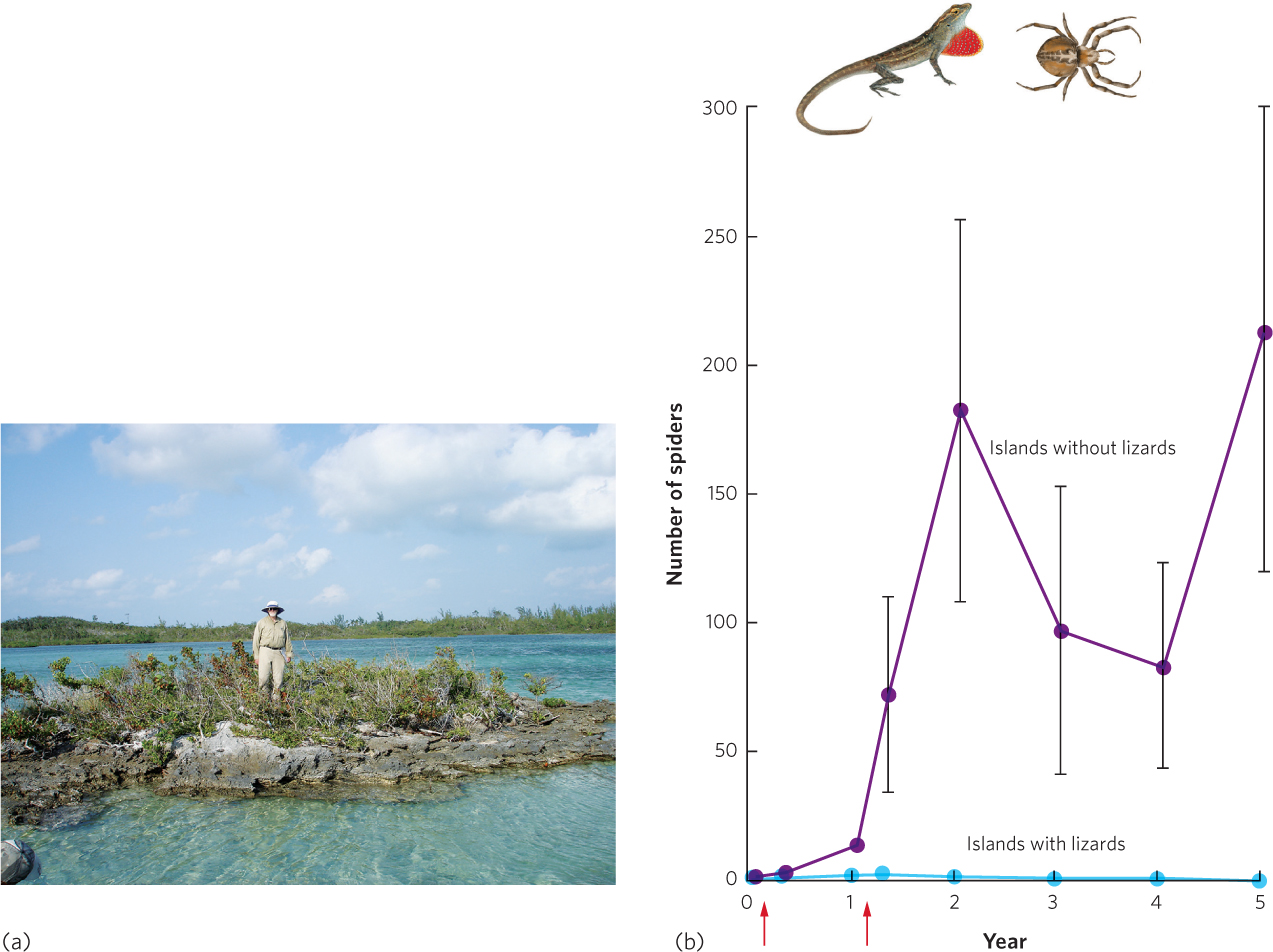
320
Sometimes the introduction of a predator is the result of an accident. When a species is introduced to a region of the world where it has not historically existed, we say that the species is introduced, exotic, or non-native. If the introduced species spreads rapidly and negatively affects other species, we say that the species is invasive. On the island of Guam, for example, many species of birds, bats, and lizards lived without predatory snakes for thousands of years. Sometime after World War II, however, the brown tree snake (Boiga irregularis) was accidentally introduced to Guam by ships carrying supplies (Figure 14.2). While the snake was native to the South Pacific, the animals on Guam had no evolutionary history of living with snakes and many had no defenses against them. Over the next 20 years, as the population of the brown tree snake grew exponentially, it had a significant and devastating effect on the island fauna. Today, Guam has experienced sharp declines or extinctions in nine species of forest-dwelling birds, all three species of bats, and several species of lizards.
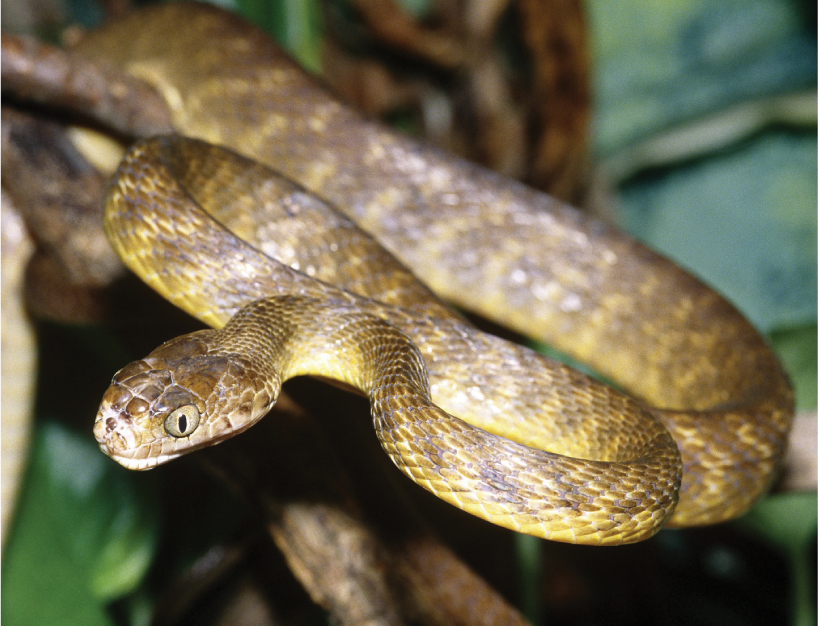
As we mentioned in Chapter 1, parasitoids represent a unique type of predator that lives within and consumes the tissues of a living host, eventually killing it. Like many other predators, parasitoids also can limit the abundance of their prey. This can be seen in an example of wasps and scale insects. The California red scale insect (Aonidiella aurantii) is a worldwide pest in citrus orchards. It feeds on the leaves and fruits of the trees, which causes a great deal of damage and makes the fruit unmarketable. Fortunately, a small species of parasitoid wasp (Aphytis melinus) is able to control the abundance of the red scale insect by laying eggs inside the scale insects and ultimately killing them.
To demonstrate the magnitude of this control, researchers in California mimicked an insect outbreak by adding large numbers of scale insects to four trees. Ten other trees with typical low numbers of scale insects served as controls. You can see the results of this experiment in Figure 14.3. Shortly after adding large numbers of scale insects, there was a significant increase in the number of juvenile and adult wasps. As the wasps became more abundant, the population of scale insects began a rapid decline. Within a few months, the large population of scale insects was reduced to the same level found on trees that had never received an experimental addition of scale insects. Although the wasps were not able to completely eliminate the scale insects, they held the population of scale insects to a level that minimally affected the citrus crops.
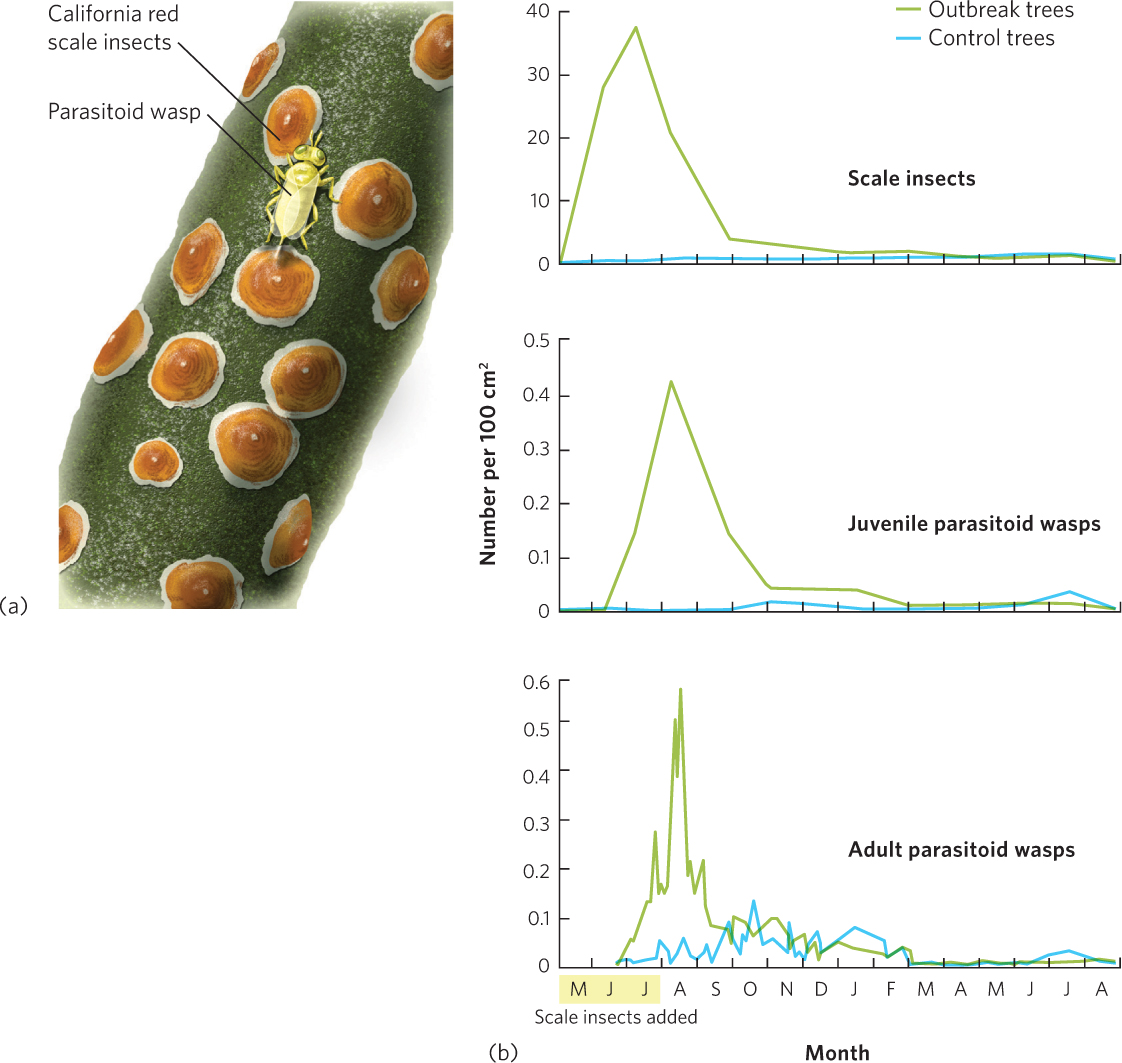
Mesopredators
Mesopredators Relatively small carnivores that consume herbivores.
Two levels of predators often exist in ecological communities: mesopredators and top predators. Mesopredators such as coyotes, weasels, and feral cats are relatively small carnivores that consume herbivores. In contrast, top predators such as wolves, mountain lions, and sharks typically consume both herbivores and mesopredators. Throughout history, top predators have interfered with human activities such as ranching, farming, hunting, and fishing. To protect our livelihood, we have reduced or eliminated the world’s top predators, but this has caused unintended consequences. In 2009 researchers estimated that the decline of the top predators in North America had allowed 60 percent of all mesopredators to expand their geographic ranges.
Top predators Predators that typically consume both herbivores and mesopredators.
321
The expansion in the range and abundance of mesopredators has had dramatic effects on the prey they consume. For example, the reduction of shark populations in the Atlantic Ocean from overharvesting has led to an increase in the cownose ray (Rhinoptera bonasus), a major mesopredator that consumes bay scallops (Argopecten irridians). This has caused a large reduction in bay scallops. In some cases, researchers have found that the benefits to humans of removing a top predator are much smaller than the damage inflicted by a mesopredator that becomes more abundant after the top predator declines. In Australia, for example, there has long been a campaign to remove dingoes and feral dogs because they kill sheep. However, removing these top predators has caused an increase in red foxes (Vulpes vulpes), which also eat sheep. This increase in red foxes has led to more than triple the loss in sheep that occurred when dingoes and feral dogs helped to control the red fox population.
Herbivores
Like predators, herbivores can have substantial effects on the species they consume. One of the classic examples is the control of the prickly pear cactus in Australia. The prickly pear cactus is a group comprised of several different species that are native to North and South America. In the nineteenth century, many of these species were brought to Australia for a variety of reasons, including use as ornamental plants and as “living fences” for pastures. The cacti rapidly spread across the continent to the point that they dominated thousands of hectares of pasture and rangeland. To combat the spread of the cactus, biologists in the 1920s collected cactus moths (Cactoblastis cactorum) in South America and introduced the moths to Australia. These moths are natural herbivores of the cactus; the caterpillar stage of the moth consumes a portion of the cactus and the injuries it causes allow pathogens to infect the plants. As you can see in the before and after photographs in Figure 14.4, the moths quickly reduced the cactus to very low abundances. While the moth has not completely eradicated the cactus because the cactus is able to disperse to moth-free areas, today the prickly pear cactus exists only in small pockets around Australia.
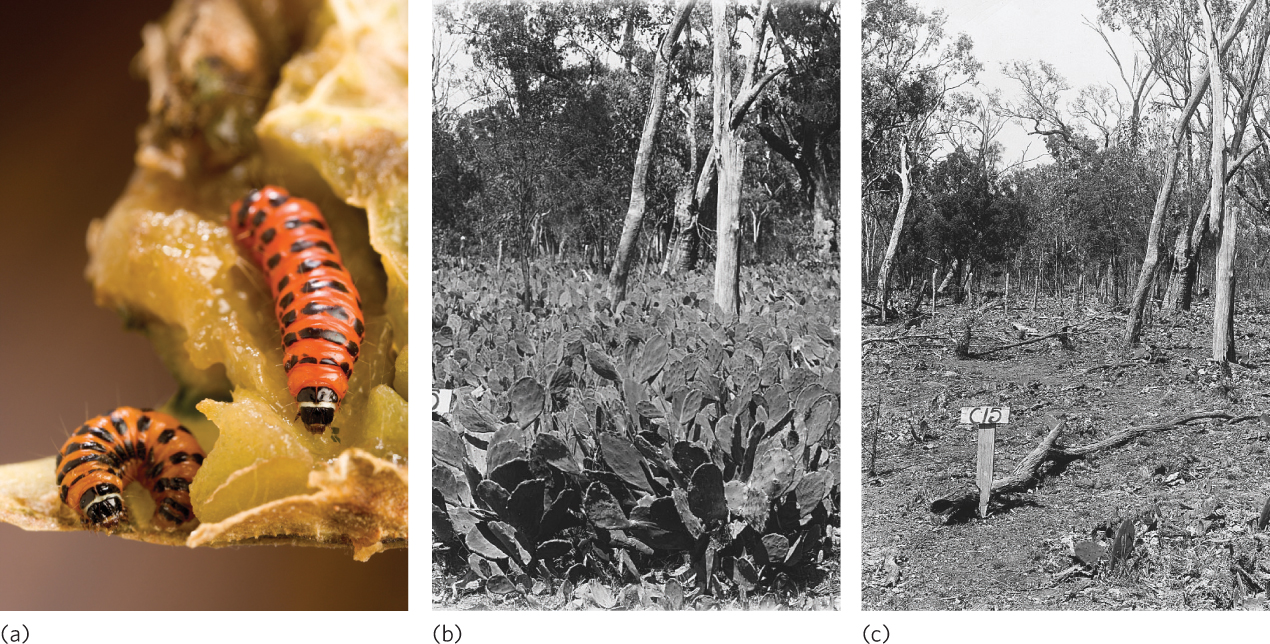
322
Herbivorous insects have been used in similar ways in North America. In California, a plant known as Klamath weed (Hypericum perforatum), which is toxic to livestock, was accidentally introduced from Europe in the early 1900s. By 1944, the weed had spread over nearly a million hectares of rangeland in 30 counties. In the 1950s, biologists decided to introduce a leaf-feeding beetle (Chrysolina quadrigemina) that consumed Klamath weed in Europe. After introduction of the beetle, the weed rapidly declined in abundance, as you can see in Figure 14.5. Biologists estimate that the beetle has now eliminated 99 percent of the Klamath weed population in North America.
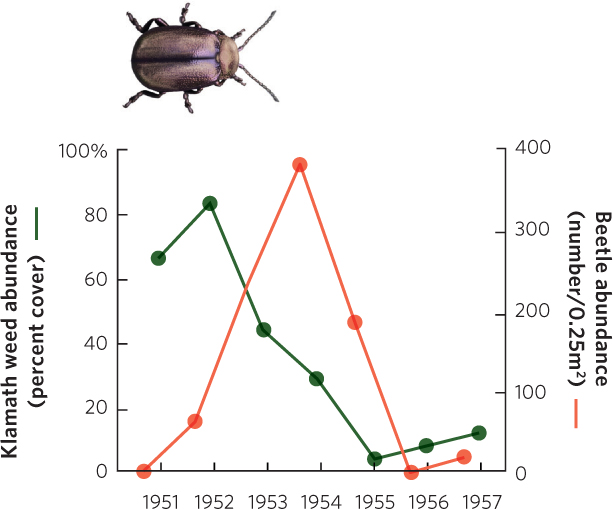
The effects of herbivores are easily observed. For example, when domesticated animals such as cattle or sheep are raised at very high densities, little plant life remains. Similarly, deer and geese can consume large amounts of plants. Their impact can be demonstrated by fencing off areas to prevent grazing; the fenced areas typically have a greater total mass, or biomass, of plants and a higher composition of plants that are preferred by the herbivores (Figure 14.6). The plant species that remain in the areas where grazing occurs are those that the herbivores prefer not to eat.
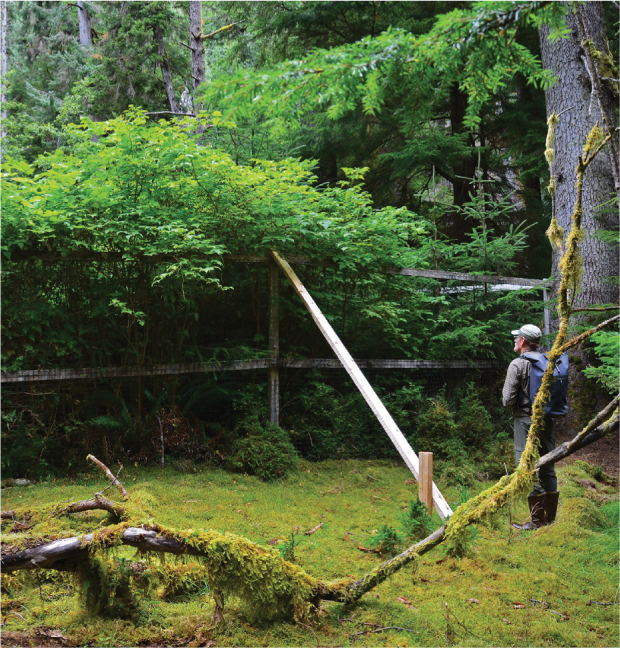
Herbivore effects also occur in aquatic habitats. In rocky shore communities, for example, sea urchins control populations of algae. When researchers conduct experiments in which they remove sea urchins from an area, the biomass of algae increases rapidly while the species composition of the algae also changes. In the presence of sea urchins, the remaining algae consist mostly of those species the sea urchins do not like and those that can withstand intense grazing. When sea urchins are removed, however, more palatable species such as the large brown algae become more abundant and can shade out the other species of algae. Such studies demonstrate that the influence of herbivores on the abundance of producers affects the species composition of the entire community.
323